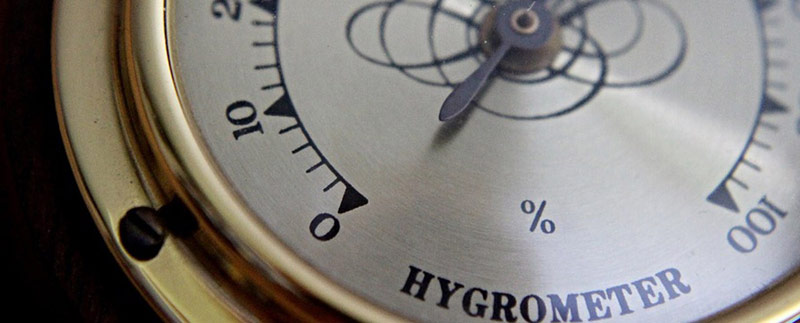Humidity’s Effects
How hot are you? How hot you feel at 80° F under the shade in an Arizona desert with nearly 0% relative humidity is quite different from 80° F experienced on a Florida coast with over 90% humidity.
Besides being uncomfortable, excessive humidity inside buildings promotes condensation, corrosion, decay, and mold. Air conditioning helps prevent these issues by not just lowering the temperature of the interior air, but also by dehumidifying (removing moisture from) the conditioned air.
On the other end of the spectrum, too little humidity can also be a problem, primarily in winter. Very low humidity increases generation of static electricity shocks, shrinkage of wood, cracking of paint, drying of skin and eyes, irritation of mucus membranes, and susceptibility of our bodies to viruses. An HVAC system with a humidifier can add needed moisture to the air.
For interior spaces, the ideal humidity range is around 40 to 50%. Monitoring the humidity level, consequently, is something HVAC controls and building automation systems should do, as well as act to maintain humidity within the “Goldilocks” zone (not too high and not too low).
Humidity, Enthalpy, and Economizers
Knowing the humidity of outside as well as inside air is also important for HVAC economizers, which use outside air for “free cooling” when conditions are right. If cooling is needed inside a building, and the temperature outside is lower than that inside return ducts, having fans and ducts bring in outside air can be less expensive than running compressors. Even though the temperature outside seems low enough, humid air may require extra conditioning, and then “free” cooling isn’t free anymore.
Moist air can hold more heat than dry air of the same (dry bulb) temperature, and almost all air has some water vapor in it. In HVAC systems, the sum of the heat energy of the dry air and heat energy of the water vapor within it is referred to as enthalpy. Humid air has higher enthalpy than dry air of the same temperature. If the enthalpy of the outside air is really less than the return air from the interior spaces, then maximizing the use of outside air will save energy. Maximum energy savings for economizers require determining inside and outside humidity for enthalpy-based control sequences. Many packaged economizers have built-in enthalpy controls.
Enthalpy-based control for economizers is more important in warmer/wetter climates. In cooler/drier climates, simpler and less expensive (dry bulb) temperature-based economizer control may be perfectly adequate.
Humidity Sensors
For an HVAC system to know what the humidity level is, a sensor must measure it automatically, accurately, and reliably. Electronic humidity sensors in HVAC applications that used capacitive polymer sensors had accuracy and durability issues. Most current models of humidity sensors incorporate silicon CMOS chips that provide more durability and reliability than older generation sensors. Plus, they respond within seconds to changes in humidity with a high degree of accuracy. Oftentimes, a humidity sensor is packaged together with a temperature sensor in the same case. With temperature and humidity sensors, you can know how “hot” it really is.
NOTE: “Humidity” in regards to human comfort is technically referring to relative humidity (the ratio of the amount of water vapor present in the air compared to the greatest amount of water vapor the air could hold at that temperature). Humidity sensors provide measurements in % RH (Relative Humidity).
If you’re interested in reading more on the subject, check out this other helpful article.
 Cart
Cart
